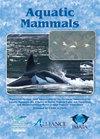Composition of Large Prey Species of Irrawaddy Dolphins (Orcaella brevirostris) in the Mekong River: Implications for Conservation of the Prey Resources
IF 0.8
4区 生物学
Q4 MARINE & FRESHWATER BIOLOGY
引用次数: 0
Abstract
Information on the feeding habits of the critically endangered Irrawaddy dolphin (Orcaella brevirostris) in the Mekong River and how their diet overlaps with that of the species targeted by fisheries is limited. The information provided herein will be helpful for evaluating and protecting important dolphin food resources. The composition of large prey species of Irrawaddy dolphins and the extent of fish resources were surveyed in the Mekong River, Cambodia, using local ecological knowledge. The results showed that Irrawaddy dolphins fed on 13 species of large fish, with Pangasius conchophilus, Cyclocheilichthys enoplos, and Hemibagrus wyckii the most frequently consumed prey. Twelve of the 13 reported prey species were usually caught by fishers. The results also revealed that the average weight of fish caught daily by fishers was significantly lower in 2019 than about five years before that, regardless of the season. A significant decline in fish resources and a high overlap of dolphin diets with fishery target species indicate that Irrawaddy dolphins may also be threatened by prey depletion, especially during the dry season when dolphins are concentrated in deep pools.湄公河中伊洛瓦底江海豚(Orcaella brevirostris)的大型猎物种类构成:对保护猎物资源的影响
有关极度濒危的伊洛瓦底江海豚(Orcaella brevirostris)在湄公河中的觅食习性以及它们的食物与渔业目标物种的食物重叠情况的信息十分有限。本文提供的信息将有助于评估和保护重要的海豚食物资源。利用当地生态知识,对柬埔寨湄公河中伊洛瓦底江豚的大型猎物种类组成和鱼类资源范围进行了调查。结果表明,伊洛瓦底江豚以 13 种大型鱼类为食,其中最常捕食的猎物是海鲈 (Pangasius conchophilus)、麒麟鱼 (Cyclocheilichthys enoplos) 和海牛 (Hemibagrus wyckii)。在报告的 13 种猎物中,有 12 种通常由渔民捕获。研究结果还显示,2019 年渔民每天捕获的鱼的平均重量明显低于五年前,与季节无关。鱼类资源的大幅减少以及海豚食物与渔业目标物种的高度重叠表明,伊洛瓦底江海豚也可能受到猎物枯竭的威胁,尤其是在海豚集中于深水潭的旱季。
本文章由计算机程序翻译,如有差异,请以英文原文为准。
求助全文
约1分钟内获得全文
求助全文
来源期刊

Aquatic Mammals
MARINE & FRESHWATER BIOLOGY-ZOOLOGY
CiteScore
1.60
自引率
16.70%
发文量
99
审稿时长
>12 weeks
期刊介绍:
Aquatic Mammals is a peer-reviewed journal sponsored by the European Association for Aquatic Mammals (EAAM), the Alliance of Marine Mammal Parks and Aquariums (AMMPA), and the International Marine Animal Trainers’ Association (IMATA). Aquatic Mammals publishes articles related to marine mammals (whales, dolphins, seals, fur seals, sea lions, walrus, dugongs, manatees, sea otters, and polar bears). Topics of publication on both captive animals and wild marine mammals include aspects of husbandry; behavior; conservation; veterinary medicine; anatomy; physiology; training; population trends; and the effects of pollution, climate change, and noise.
 求助内容:
求助内容: 应助结果提醒方式:
应助结果提醒方式:


